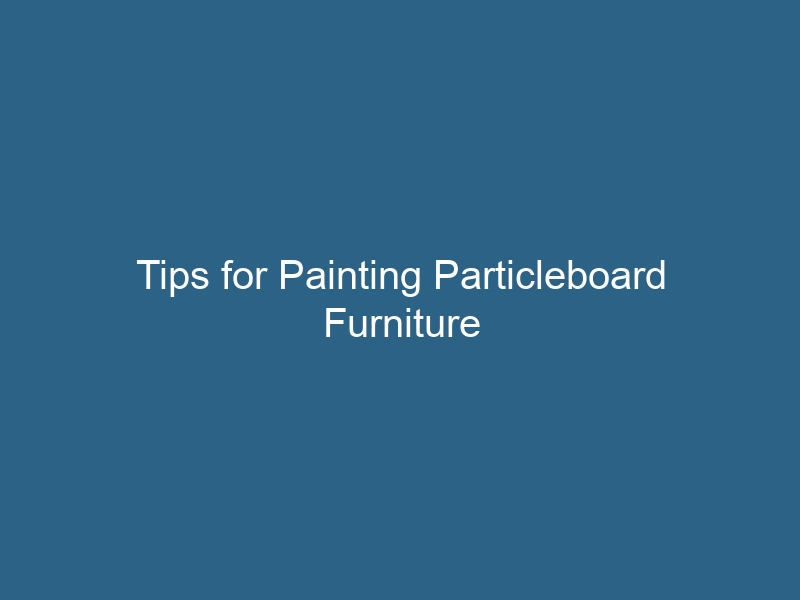Quck answer
1. Clean the surface: Start by cleaning the particleboard furniture to remove any dirt, dust, or grease. Use a mild detergent and water solution and a soft cloth or sponge to wipe down the surface. Allow it to dry completely before proceeding.
2. Sand the surface: Particleboard has a smooth and non-porous surface, so it’s important to sand it to create a rough texture for better paint adherence. Use fine-grit sandpaper and sand in a circular motion until the surface feels slightly rough.
3. Prime the furniture: Apply a coat of primer specifically designed for particleboard furniture. This will help the paint adhere better and prevent the particleboard from absorbing moisture. Follow the manufacturer’s instructions for drying time.
4. Paint the furniture: Once the primer is dry, apply your desired paint color using a brush or roller. Start with thin coats and allow each coat to dry before applying the next. This will help prevent drips and ensure an even finish. Consider adding a second coat for better coverage.
5. Seal the paint: To protect the painted surface and make it more durable, apply a clear topcoat or sealer. This will also give the furniture a smoother and more polished look. Follow the manufacturer’s instructions for drying time.
6. Allow the furniture to cure: After painting and sealing, allow the furniture to cure for the recommended time before using or placing any objects on it. This will ensure that the paint fully hardens and provides a long-lasting finish.
Note: It’s important to choose the appropriate paint and primer for particleboard furniture, as not all types of paint will adhere well to this material. Consult with a paint professional or refer to the manufacturer’s instructions for the best results.
Particleboard furniture has a similar appearance to solid wood, but it requires different techniques when it comes to restoration. Unlike solid wood, particleboard is made up of small wood particles bonded together with resin and covered in a laminate. This smooth surface makes it difficult for paint to adhere, but with careful sanding and preparation, you can successfully paint particleboard furniture.
Preparing the Furniture
Start by removing all hardware, doors, and drawers from the furniture. Use masking tape and a felt-tip marker to label bags for screws and other hardware. Clean the furniture’s surface and place it on a drop cloth in a well-ventilated area to prevent dust and dirt from ruining the paint.
Repairing Damaged Areas
If there are chips or divots on the particleboard, use wood filler and a putty knife to repair them. For water damage bubbles, cut off the laminate with a razor blade and fill the depression with wood putty. Let the putty dry overnight and then sand it with 220-grit sandpaper until it is smooth and even with the rest of the surface.
Sanding the Furniture
Use 220-grit sandpaper to roughen the surface of the particleboard laminate. This will create a suitable texture for the primer to adhere to. Be cautious not to oversand and only aim to remove the shine from the laminate. Wipe away any dust with a tack cloth before applying the primer.
Applying Primer
Primer is essential to ensure the paint adheres properly to the furniture. You can use either oil-based or water-based primer for particleboard. Look for a primer that promotes adhesion for best results. One coat is usually enough, but if the original color is still visible, apply a second coat after the first one has dried. If the primer is too thick or has drips, let it dry overnight and smooth it out with 220-grit sandpaper. Use a tack cloth to remove any dust residue.
Painting the Furniture
Choose an oil-based paint as some acrylics can damage the laminate. Apply thin layers of paint using a roller with a 1/4-inch nap or a synthetic flat brush for flat surfaces, and an angled brush for corners. Allow each coat to dry according to the manufacturer’s instructions before applying another coat. The primer will reduce the need for multiple paint coats, but if you feel the paint is not finished after two coats, apply a third.
Finishing Touches
Once the paint is fully dry, apply a coat of polycrylic finish to protect the surface from damage. Follow the manufacturer’s instructions for curing time. Finally, reassemble the furniture.


